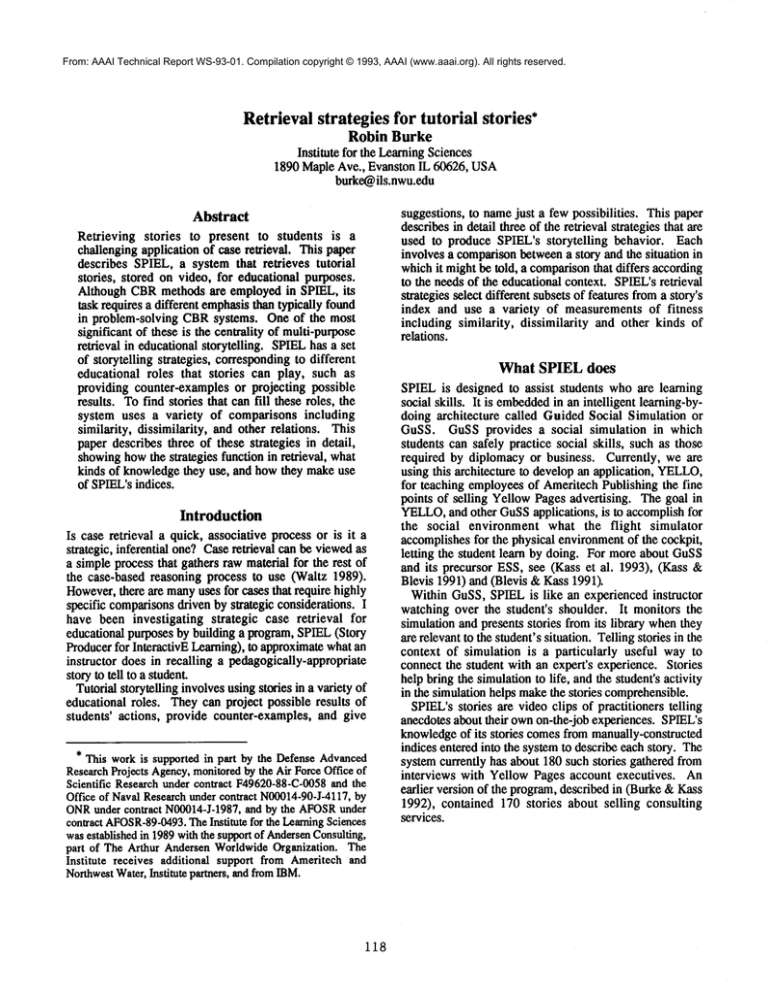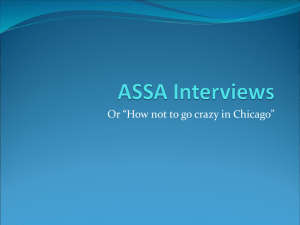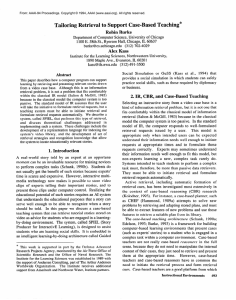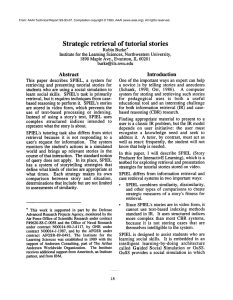Retrieval strategies for tutorial stories* Robin Burke
advertisement

From: AAAI Technical Report WS-93-01. Compilation copyright © 1993, AAAI (www.aaai.org). All rights reserved.
Retrieval strategies for tutorial stories*
Robin Burke
Institute for the LearningSciences
1890 Maple Ave., Evanston IL 60626, USA
burke@ils.nwu.edu
suggestions, to namejust a few possibilities. This paper
describes in detail three of the retrieval strategies that are
used to produce SPIEL’s storytelling
behavior. Each
involves a comparisonbetweena story and the situation in
which it might be told, a comparisonthat differs according
to the needs of the educational context. SPIEL’sretrieval
strategies select different subsets of features froma story’s
index and use a variety of measurements of fitness
including similarity, dissimilarity and other kinds of
relations.
Abstract
Retrieving stories to present to students is a
challenging application of case retrieval. This paper
describes SPIEL, a system that retrieves tutorial
stories, stored on video, for educational purposes.
Although CBRmethods are employed in SPIEL, its
task requires a different emphasisthan typically found
in problem-solving CBRsystems. One of the most
significant of these is the centrality of multi-purpose
retrieval in educational storytelling. SPIELhas a set
of storytelling strategies, corresponding to different
educational roles that stories can play, such as
providing counter-examples or projecting possible
results. To find stories that can fill these roles, the
system uses a variety of comparisons including
similarity, dissimilarity, and other relations. This
paper describes three of these strategies in detail,
showinghowthe strategies function in retrieval, what
kinds of knowledgethey use, and how they make use
of SPIEL’sindices.
What SPIEL does
Introduction
Is case retrieval a quick, associative process or is it a
strategic, inferential one? Case retrieval can be viewedas
a simple process that gathers raw material for the rest of
the case-based reasoning process to use (Waltz 1989).
However,there are manyuses for cases that require highly
specific comparisonsdriven by strategic considerations. I
have been investigating strategic case retrieval for
educational purposes by building a program, SPIEL(Story
Producer for Interactive Learning), to approximatewhat an
instructor does in recalling a pedagogically-appropriate
story to tell to a student.
Tutorial storytelling involves using stories in a variety of
educational roles. They can project possible results of
students’ actions, provide counter-examples, and give
* This workis supported in part by the DefenseAdvanced
ResearchProjects Agency,monitoredby the Air ForceOffice of
Scientific Research under contract F49620-88-C-0058
and the
Office of NavalResearchunder contract N00014-90-J-4117,
by
ONRunder contract N00014-J-1987,and by the AFOSR
under
contract AFOSR-89-0493.
The Institute for the LearningSciences
wasestablished in 1989with the supportof AndersenConsulting,
part of The Arthur Andersen WorldwideOrganization. The
Institute receives additional support from Ameritech and
NorthwestWater,Institute partners, and fromIBM.
118
SPIEL is designed to assist students who are learning
social skills. It is embedded
in an intelligent learning-bydoing architecture called Guided Social Simulation or
GuSS. GuSS provides a social simulation in which
students can safely practice social skills, such as those
required by diplomacy or business. Currently, we are
using this architecture to develop an application, YELLO,
for teaching employees of Ameritech Publishing the fine
points of selling Yellow Pages advertising. The goal in
YELLO,
and other GuSSapplications, is to accomplish for
the social environment what the flight simulator
accomplishes for the physical environment of the cockpit,
letting the student learn by doing. For more about GuSS
and its precursor ESS, see (Kass et al. 1993), (Kass
Blevis 1991) and (Blevis &Kass 1991).
Within GuSS, SPIEL is like an experienced instructor
watching over the student’s shoulder. It monitors the
simulation and presents stories from its library whenthey
are relevant to the student’s situation. Telling stories in the
context of simulation is a particularly useful way to
connect the student with an expert’s experience. Stories
help bring the simulation to life, and the student’s activity
in the simulation helps makethe stories comprehensible.
SPIEL’sstories are video clips of practitioners telling
anecdotes about their ownon-the-job experiences. SPIEL’s
knowledgeof its stories comes from manually-constructed
indices entered into the systemto describe each story. The
system currently has about 180 such stories gathered from
interviews with Yellow Pages account executives. An
earlier version of the program, described in (Burke &Kass
1992), contained 170 stories about selling consulting
services.
Standard problem-solvinl~
Story retrieval in SPIEL
Incremental
Beforeretrieval
Cue composition
Relrieval criteria
Solves a similar problem
Makesan educational point
Case structure
Represents problem solution
Video clip
No
Yes
Mandator~retrieval
Yes
No
Case evaluation
Between-case competition
Yes
No
Table 1. Differences betweencase retrieval in _oroblem-solvingCBRand story retrieval in SPIEL
Story retrieval vs. case retrieval
Educational tasks emphasize different requirements for
case retrieval than most problem-solving tasks. Table 1
summarizes some of the most important differences in
emphasis.
Cue composition: One of the major differences between
SPIEL and the standard problem-solving CBRmodel
(Kolodner & Jona 1992) is the way retrieval cues are put
together. CBRsystems create a retrieval cue by analyzing
a statement of the problem to be solved. SPIELretrieves
its stories based on a continuous stream of actions by the
student and the GuSSsimulation. Anyevent in the history
of the interaction could be relevant to the retrieval of a
tutorial story. So, SPIELhas to build its retrieval cues
incrementally throughout this on-going process.
Mandatoryretrieval: A case-based problem solver
must retrieve something, otherwise there will be no basis
for building a solution. If what is retrieved is not a
directly-applicable solution, it can be adapted. However,
in teaching, there are manystudent states for which there
will be no appropriate story to tell. Becauseit cannot adapt
its stories, SPIELhas to retrieve only closely-relevant
ones. A story that is far afield from the student’s
immediate concerns will be confusing. If SPIEL cannot
find a very good story, it is better off waiting for the
student to do something else. Usually, there is an
appropriate story about once every 10-20 student actions.
Case evaluation: In the standard CBRmodel, the
retrieval step uses indices to retrieve a set of candidate
cases. The candidate cases themselves are then examined
and evaluated, and the best case is chosenas the basis for a
problem solution. The evaluation step enables the system
to reject inappropriately retrieved cases. SPIELhas no
language capacity with which to understand or evaluate the
video clips it retrieves. It must retrieve conservatively,
because whatever is retrieved will be presented to the
studenL
Between-casecompetition: Educational stories are not
in competition to be the single right answer, as in many
retrieval models,such as (Thagardet al. 1990). If there are
stories from experts with opposing viewpoints on the
student’s situation, SPIELneeds to showthe student the
whole range of opinion by making all retrieved stories
available.
These differences have three notable consequences for
the designof a tutorial case retriever.
119
Because SPIEL does not have access to the content of
what it is retrieving, the index has to contain everything
that the system will need to decide to tell the story. It
needs indices that are more detailed and complex than
those typically used in case retrieval.
There is an implicit theory of problem solving in the
similarity metrics found in problem-solving CBR:the more
similar the input problem is to the problemsolved by the
case, the morelikely it is that the solutions will also be
similar. SPIEL’sretrieval strategies also embodya theory
of good cases for the educational context. They involve
different kinds of judgmentsfrom those found in similarity
metrics.
In SPIEL,a tutorial opportunity is defined as a situation
for which there is a relevant story to tell. It does a
storyteller no goodto recognize a goodtime to tell a story
it doesn’t have. A similar insight was behind the design of
ANON(Owens 1990), which used its case base
determine what features to search for in the input problem.
SPIEL uses its story base in a similar way to guide the
search of the events in the simulation.
The rest of this paper focuses mainly on retrieval
strategies,
but I touch briefly on the indexing and
implementationissues to put the strategies in context.
Implementingstorytelling strategies
One way to think about the problem an educational
storyteller faces is to think of each story as a possible
lesson and each strategy as a way to teach it. Storytelling
strategies indicate the conditions under which the goal of
telling a story can be achieved. Since a storyteller has
manystories, any one of which could be relevant at any
time, it is useful to think of it as an opportunisticsystem.
However,educational storytelling is not as open-ended
as the general case of opportunism whose complexities
were laid out in (Birnbaum 1986). SPIEL’s storytelling
strategies comparestories about an activity to specific
contexts of student action. They seek coherence and
relevance, not distant analogies. It is possible to describe
concretely what an opportunity to tell a story using a
particular strategy wouldlook like.
SPIELalso has a strong advantage over the problem of
opportunism in that it is embeddedin a simulation. No
truly novel actions can occur in GuSSsince the student is
constrained by the program’s interface and the simulation
operates in known ways. SPIEL knows with certainty
what actions can and cannot happenin its world.
Storage
generation
~ IMic~~ St°rytelling
I strategies
Opportunity-recognition
rules
Retrieval
C
Opportunity-recognition
rules
Retrieved
Eventsfrom---{~1 Marcher
~- story/strategy
simulation
I
I
Language
generat~
Story with bridge andcoda
Figure 1. SPIEL’sprocessing
SPIEL’s problem of opportunism is therefore much
simpler than the general one. The simulated world
provides a limited space in which events can occur;
storytellingstrategies single out preciseareas of the space
that constitute opportunities. Theseproperties enable
SPIELto use what Birnbaumcalls the "elaborate and
index" modelof opportunism:
...spend someeffort, whena goal is formed, to
determinea numberof situations in whichit mightbe
easily satisfied...and then indexthe goal in termsof
all the features that mightarise in suchsituations.
(pg. 146)
SPIELworksfrom its database of stories to determine
whatis an opportunityfor intervention.Its processingcan
be dividedinto two phases: storage time, whennewstories
are put into the system and the systemconsiders howit
mighttell them;andretrieval time, whena studentinteracts
with the GuSSsystem and and SPIEL watches for
opportunities to give tutorial feedback. Figure 1 shows
these phases.
At storagetime:
1. Indicesare attachedto eachstory in the database.
2. SPIEL’sstorytelling strategies are applied to each
index.If the strategyis applicableto the index,a set
of rules is generated that will recognize an
opportunityto tell that story using the storytelling
strategy.
Atretrieval time:
1. Opportunity-recognition
rules are matchedagainst the
state of the simulation.
2. Whenthe rules for a particular combinationof story
andstrategymatchsuccessfully,the story is retrieved.
120
.
After retrieval, natural languagebridgeand codaare
generatedto integrate the story into the student’s
current context.
Indices for educational stories
SPIEL’sindices are created manually.Sincethe stories are
in video form, automaticprocessing wouldentail speech
(and possibly gesture) recognition as well as natural
languageunderstanding.SPIEL’sdesigntherefore calls for
a humanindexerto watcheach story being told and use an
indexing tool to compose indices that capture
interpretationsof the story’s meaning.
Theseinterpretations havethe general form, "Xbelieved
Y, but actually Z," which is a form of anomaly. An
anomaly is a failure of expectation that requires
explanation (Schank 1982). Typically, anomalous
occurrencesare whatmakestories interesting and useful,
and they are a natural wayto summarizewhat a story is
about. Anomalies
are especially importantin stories about
social activity since students are learning what
expectations they should have and how to address
expectationfailures.
The anomaly forms the core of SPIEL’s indexing
representation. Considerthe story transcribed here whose
indexis shownin Figure2.
I wentto this auto glass place onetime whereI had
the biggest surprise. I walkedin; it wasa big, burly
man; he talked about auto glass. So we were
workingon a display ad for him.
It waskind of a rinky-dinkshop and there wasa TV
playing and a lady there watchingthe TV.It was a
soap operain the afternoon.I talked to the mana lot
but yet the womanseemedto be listening, she was
Setting: step-of-sales-process(salesperson,
pre-call)
business-type(service)
business-size(small)
business-partnership(auto-glass
man,wife)
marded(auto-~lass
man,wife)
sales-target(salesperson,autc-~lass company)
Anomaly:l salesperson [ assumed
ii MeI
theme I
Assumed ~
’ Actual
Theme: housewife
business panner
Goal: hospitalit~
help in decision
Plan: small
talk
evaluatepresentation
Result:
positive evaluation
Pos.side-effect:
sale for salesperson
Neg.side-effect:
Fit, ure 2. Indexfor "WifewatchingTV"story_
asking a couple of questions. She talked about the
soapoperaa little bit andaboutthe weather.
It turns out that after he and I workedon the ad, he
gaveit to her to approve.It turns out that after I
broughtit backto approve,she approvedthe actual
dollar amount.Hewas there to tell me about the
business, but his wife wasthere to hand over the
check.
So if I hadignoredher or had not givenher the time
of day or the respect that she was deserved, I
wouldn’thave madethat sale. It’s important when
youwalkin, to really listen to everyoneandto really
payattention to whateveris goingon that yousee.
Theindex contains
¯ the anomalyin the story, whichcan be phrased as
"the salesperson assumedthe wife wouldhave the
role of housewife,but actually she was a business
partner."
¯ the setting, the story’s position within the overall
social task, includinga representationof the social
relationshipsbetweenthe actors in the story, and
¯ intentional chains surrounding and explaining the
anomalousoccurrences.
SPIEL’sindices are considerably more complexthan
those typically found in case-based reasoning systems.
Thefact that SPIEL’scases are video clips is part of the
reason. Its indices have to say everything that SPIEL
needsto knowaboutits stories since the stories themselves
cannot be evaluated. Anotherreason that SPIEL’sindices
showcomplexityis the task of educational storytelling
itself. SPIELhas a variety of reasonsfor telling stories,
each of whichrequires a slightly different perspectiveon
the index. SPIELneeds complexindices to meet the
demands
of a variety of strategies. Thethree strategies I
describe next showsomeof these uses. Theothers can be
foundin (Burkein preparation).
121
The Warn about plan storytelling
strategy
Astorytelling strategy is a wayof using a story to teach.
Consider Example1, which shows the Warnabout plan
strategy in action. Thestudent is pressing for a large ad
campaign,muchlarger than the client needsor can really
afford. The customeris an evasive type, and does not
immediately
reject the idea: instead, he stalls. Thestudent
couldlose a lot of time in a futile effort to makethis sale.
At this point, the storyteller interveneswith a story about
an analogoussituation where, instead of stalling, the
customer rejected the ad program and rebuked the
salesperson. Telling the story at this point helps the
student identify the problembefore goingtoo far along in
this direction.
Anaccurate assessmentof howfar to let the student go
wouldrequire a great deal of knowledge
about the scenario
the student is engagedin, moreknowledge
than is available
to SPIEL.GuSS’sopen-endedsimulation design does not
allow any quick read-out of what outcomesare likely and
howfar awaythe student is from obtaining them. SPIEL
would have to perform a complete envisionment of
possible simulationoutcomesto find out, moreprocessing
than can be accomplished in the midst of student
interaction. Instead, SPIELuses prototypical knowledge
about inconclusive outcomes. For SPIELto tell the
"Wouldyou buy this ad?" story in the example,it must
knowthat overcoming
the customer’sstall in this kind of
case is time-consuming
andnot particularly educational.
At storagetime, eachstorytelling strategyselects stories
that are compatiblewith its educationalrole. Astory with
a good outcomecould not be sensibly used with Warn
about plan, for example. The second task of the
storytelling strategy is to generate, for each compatible
story, a Recognition Condition Description (RCD),
representationthat describesa situation in whichthe story
¯ Thestudent doesn’t gather very muchinformationat the
pre-call stage.
¯ Backat the office, the studentpreparesa very large ad
campaign.
¯ Whenthe student presents this to the client, the client
says"Youknow,I really haveto talk to Edaboutthis..."
and is inwardly very doubtful of the value of such a
large expenditure.
Storyteller: Astory abouta failure in a situation similar to
yours...
Youmadea recommendationthat was muchlarger than
Dave’sexpectations. Here is a story in whichdoing that
led to problems:
"I remember
myfirst year 1970.I wason myfirst Yellow
Pagesales canvass. In those days, they didn’t give youa
lot of time to showability andI wasn’tdoingvery well.
Mymanagertold methat I hadone weekto start producing
or they weregoingto let mego.
"I called on a graphicartist in Indianapolis.Hehada 2HS,
a one-inchad. I walkedin, askedtwominorquestions, and
I laid downa quarter-pagepiece of spec in front of this
manand told him he needed this ad. The manlooked at
meandhe said, ’Would
youbuythis ad?’ Heturnedit right
back to me. I didn’t knowwhat to say. It shockedme.
Finally, I said, ’No, I wouldn’t.’Hedidn’t needa quarter
page; a one-inch ad is what he needed. The gentleman
proceededto give it to me,up oneside anddownthe other.
Hetold methat I was there for myowngreedyinterests,
trying to makecommissions
instead of taking care of his
advertisingand caring abouthim. Hesaid, ’If you’reever
goingto makeit in this business,you’dbetter start paying
attention to yourcustomers.’
"I walkedout of that call a different salesmanbecauseI
realized then that the only wayto sell YellowPagesis to
sell whatthe customerneeds, not what I need. Learning
that lesson tamedmysales career around.I started making
sales, andby the end of the canvass,I wasoneof the top
producers."
Youmadea recommendation
that is muchlarger than the
client’s expectations.Thatmightnot be a goodidea.
Example1. Telling "Wouldyou buy this ad?"
using the Warn
aboutnlan strategy
could be told using the strategy, a tutorial opportunity
providedby the story.
Computingthe RCDinvolves makinginferences based
on the story’s index, essentially askingthe question"What
wouldhave to happenfor this story to be goodto tell?"
The answer to this question is different for every
storytelling strategy. For Warnabout plan, the situation
shouldbe pretty muchthe sameas in the story: the student
should have overshot the markby designing a large ad
program.The difference is that the student should be
unlikelyto discoverthis error. Immediate
rejection, which
is the bad outcomeof the story, is not what should be
looked for. Instead, the system needs an inconclusive
outcome
that bodesill.
Whatoccurs in Example1 is one kind of outcomeof this
kind: if the personthe studentis talkingto has authorityto
122
buy and that person defers the decision to someoneelse,
this is usually an evasive maneuver,not motivatedby a
real needfor consultation.Also, if the customerdelaysthe
decision:"I don’thavelime for this now.Let’s talk aboutit
next week."Neitherof these objectionsare associatedwith
any of the importanteducational goals of the system, so
interventionis justified.
A descriptionof the RCD
that characterizes the tutorial
opportunitywouldthereforelook somethinglike this:
WHEN
the student is closing the sale andspeakingto
someonewhois the decision maker,
LOOK
FORthe student to present a very large
ad program,
the client to havea negativebelief about
that program,and
the client to defer the decisionto another,
or the client to put the decisionoff to
anothertime,
THENTELL"Wouldyou buy this ad?"
ASa "Warnabout plan" story.
This is the formatof an RCD.It contains a trigger (the
"when"part) that describesthe conditionsunderwhichthe
opportunity becomespossible, usually a function of the
stage of the sales processthat the studentis in, combined
with characteristics of the other agents involvedin that
stage. If the triggeringconditionsare met,the systemtries
to gather evidencethat similar intentionsare at workin the
simulation.
Warnabout plan can also be used to showeffects that
wouldnot appear within the scenario. For example,scare
tactics maypersuadea customerto buy once, but they hurt
the client relationship and eventually result in lost
business. This problemdoes not showup in YELLO
since
a scenario ends whenthe student makes one sale. A
student whosuccessfullyuses this tactic in the simulation
might think it is a good idea in general unless the
storyteller can showan exampleto demonstrateotherwise.
Another use of the storytelling strategy is in the
generationof the natural languagetexts that surroundand
explain the story. As shownin Example
1, there are three
parts to the explanation:the headline, for the attentiongetting initial statement; the bridge, the introductory
paragraphexplaining whythe story has comeup; and the
coda, that closes the story presentation with a
recommendation
or evaluation. Eachstrategy has a set of
natural languagetemplatesfor these texts, whichare filled
in by generatingappropriatephrasesat retrieval time.
The Demonstrate risks storytelling
strategy
There is tremendousvariability in the social world.
Approachesthat have always workedmayfail in a new
situation for no apparentreason; unlikely strategies may
fortuitously succeed.Bothin GuSS’ssimulator andin real
life, the learner gets to see only one outcomeat a time.
Oneimportantrole that real-world stories can play is to
illustrate the range of real experience by presenting
counter-examplesthat contrast with what is happeningto
the student. Studies of apprenticeshipsituations indicate
that experts often use stories in exactly this way(Lave
Wenger1991).
TheDemonstraterisks strategy showsthat a successful
result in the simulationis not alwaysrepeatablein the real
world. Considerthe situation wherethe student closes a
sale, but continuesconversingwith the customer.This is
risky, since it gives the customer an opportunity to
reconsider. To show the risk, SPIEL tells about a
salespersonwholost a sale througha careless remarkmade
after a sale wasclosed.
This strategy resembles Warnabout plan because it
uses a story about a failure to warn the student. The
difference is that the Warn
aboutplan strategy is used
whenthe simulation is not likely to give immediate
feedback about the student’s actions. The Demonstrate
risks strategy looksfor the simulationgivingfeedback,but
of the wrongkind. It waits for the simulation to do
somethingopposite from the outcomefound in the story,
and tells a story to show howthe real world can be
different fromthe simulation.
This approachto retrieving counter-examplesdiffers
from existing CBRsystemsthat use contrasting examples,
such as HYPO
(Ashley & Rissland 1987). HYPO
retrieves
cases based on similarity along certain dimensionsand
buildsa structure, the claimlattice, of the retrievedcases,
enablingit to identify contrasts along other dimensions.
SPIELuses its knowledgeof contrasts in the retrieval
processitself, so that it onlyretrievesthosecasesthat make
the needededucationalpoint.
To arrive at the recognition condition description for
such a tutorial opportunity,SPIELmustlook for a result
that wouldbe opposite fromwhatoccursin the story. The
story described aboveshoweda salespersonlosing a sale
during conversationafter the close of a sale. SPIELuses
an opposite-finding inference mechanismto identify a
outcomewhich is opposite from the one shownin the
story. Thestory is a goodcounter-example
if the student
doesa similar action, but doesnot lose anything.
The "Warn about assumption" strategy
Newcomersto a social domain may inappropriately
transfer expectationsfromthe rest of their social lives. A
newsalespersonmaythink, for example,that a friendly,
talkative customeris morelikely to buythan a "get down
Storytellingstrategy Summary
Tell a story aboutan unsuccessfulplan
Warnabout plan
whenthe student has begunexecutinga
similar plan.
Demonstraterisks
Warnabout
assumption
to business"type, whenin manycases, the oppositeis true.
Sincethe indices usedfor stories incorporatethe difference
betweena person’s view of the world and howthe world
actually turned out to be, SPIELis well poised to help
studentsby pointingout their unrealisticexpectations.
If the programhas evidence that the student has a
particular assumption, the Warnabout assumption
strategy calls for it to tell a story about a time whena
similar assumptionwas wrong.Supposethe student has an
opportunityto gather informationabout a client’s business
fromthe client’s spouse,but doesnot take that opportunity.
It is reasonableto infer that the student assumesthat the
spouse does not have an importantrole in the business.
SPIELcan tell the "WifewatchingTV"story at this point,
showinga case wherea similar assumptionprovedwrong.
I call this type of strategy is a perspective-oriented
strategy, becausewhat is important is the contrasting
perspective in a story. Recognizingstories that are
relevant in this wayis moredifficult than recognizing
stories that contain similar actions. Perspective-oriented
strategies need knowledgeabout howcertain actions are
characteristic indicators of the student’s mentalstate.
Students do not alwaysact in waysthat clearly indicate
their beliefs, but if they do, the systemshouldbe prepared
to respond. In this story, the salespersonassumes,in an
information-gathering
context, that the client’s spousewill
not havea business role. Whatactions wouldindicate such
an assumption on the student’s part? In information
gathering, the primarytask is to ask questions about the
client’s business.If the studentfails to ask suchquestions
of someonewhengiven the opportunity, this is a good
indicationof an assumption
on the student’spart that there
is no information to gather. Anotherpossible indicator
wouldbe a deliberate act on the student’s part to exclude
the spousefromthe sales presentation.
Conclusion
Thethree storytelling strategies describedin this paperand
summarized
in Table 2 showsomeof the demandsthat the
task of educationalstorytelling places on a case retrieval
system. The retriever must not only respond to crucial
similarities between
a story andthe situation in whichit is
told, but also differences, such as opposite outcomesas
called for by the Demonstrate risks strategy, and
Tutorial opportunity
Lookfor similar setting, similar
goal andsimilar plan.
Lookfor a negative, but
inconclusive outcome.
The negative
Lookfor similar setting, similar
Tell a story abouta negativeresult of a
outcomeof a plan. goal andsimilar plan.
particular plan whenthe studenthas just
Lookfor an opposite outcome.
executeda similar plan but hadsuccess.
Tell a story aboutan erroneousassumption An assumptionthat Lookfor similar setting.
didn’t hold.
Lookfor actions that are
that someonemadewhenthe student
appears to have madethe sameassumption.
indicative of the assumption.
Table2. Summary
of the three storytelling strategies
123
Storyis about:
The negative
outcomeof a plan.
evidential relations, used by Warnaboutassumption
and
other perspective-orientedstrategies that look for actions
that indicatebeliefs.
Thedesign of SPIELis a responseto these demands.It
uses structured, strategic comparisons
betweenstories and
the situations in whichthey are told. Theseretrieval
strategies are an explicit counterpartto whatis implicit in
the similarity metrics used in standard problem-solving
case retrieval: a theory of whatcases are useful for the
task. Extensionsof the standardproblem-solving
paradigm
(Kolodner, 1989) and newapplications for case-based
reasoning technology, such as education, entail new
notions of utility, and with them,newmetrics that combine
similarity judgmentsandother measuresof fimess.
Putting such strategies to workneed not render case
retrieval prohibitively inefficient. Since strategies are
implementedas proceduresthat operate at storage time,
SPIELperformsa minimum
of inference at retrieval time,
yet still remainssensitive to the strategic considerations
involvedin recognizingtutorial opportunities.
Acknowledgments
The GuSSproject has prospered under the guidance of
RogerSchank,Alex Kass and Eli Blevis. I wouldlike to
acknowledge
their contributionto the ideas in this paper.
GuSSis the product of manymindsand efforts including
those of Mark Ashba, Greg Downey,Debra Jenkins,
SmadarKedar, Jarret Knyal, MariaLeone,Charles Lewis,
John Miller, Thomas Murray, Michelle Saunders,
JeannemarieSierant, and MaryWilliamson.Thesales and
sales training organizationsof AmeritechPublishinghave
also contributedto this researchin manyways.
References
Ashley,K., and Rissland, E. 1987. Compare
and Conlrast,
ATest of Expertise. In Proceedingsof the 6th National
Conference
on Artificial Intelligence. AAAI.
Birnbaum,L. A. 1986. Integrated Processing in Planning
and Understanding. PhD thesis, Dept. of Computer
Science,YaleUniversity.
Blevis, E. andKass, A. 1991.Teachingby Meansof Social
Simulation.In Proceedingsof the International Conference
on the LearningSciences. AACE.
Burke, R. 1992. Knowledge
acquisition and education: a
case for stories. In Proceedings of the Symposium
on
Cognitive Aspectsof Knowledge
Acquisition. AAAI.
Burke, R. in preparation. Representation, Storage and
Retrieval of Stories in a GuidedSocial Simulation. PhD
thesis, Dept. of EECS,
Northwestern
University.
Burke,R. and Kass,A. 1992.Integrating CasePresentation
with Simulation-basedLearning-by-doing.In Proceedings
of 14th Annual Conference of the Cognitive Science
Society, 629-634.Hillsdale, NJ: LawrenceErlbaumAssoc.
Domeshek,E. 1992. Do the Right Thing: A Component
Theoryfor IndexingStories as Social Advice.PhDthesis,
Dept. of ComputerScience, Yale University. Issued as
124
Technical Report No. 26, Institute for the Learning
Sciences.
Edelson, D. 1993 Learning from Stories: Indexing,
Remindingand Questioning in a Case-based Teaching
System. PhD thesis, Dept. of EECS, Northwestern
University.
Gentner, D. and Forbus, K. 1991. MAC/FAC:
A Modelof
Similarity-BasedRetrieval. In Proceedingsof 13th Annual
Conferenceof the Cognitive Science Society. Hillsdale,
NJ: LawrenceEflbaumAssoc.
Hammond,K. 1989. Case-based Planning: Viewing
Planningas a Memory
Task. Boston: AcademicPress.
Kass, A. and Blevis, E. 1991. Learning Through
Experience: An Intelligent Learning-by-DoingEnvironment for Business Consultants. In Proceedings of the
Conference on Intelligent Computer-AidedTraining.
NASA.
Kass, A.; Burke, R.; Blevis, E.; and Williamson,M. 1993.
Constructing Learning Environmentsfor ComplexSocial
Skills. Journalof the LearningSciences.Toappear.
Kolodner,J. 1989. JudgingWhichis the ’Besf Casefor a
Case-basedReasoner. In Proceedings of the Case-Based
Reasoning Workshop. DARPA/ISTO.
Kolodner,J. and Jona M. 1992. Case-basedReasoning.In
Encyclopedia
of Artificial Intelligence(2nded.), S. Shaprio
(ed.). NewYork: Wiley.
Lave, J. and Wenger, E. 1991. Situated Learning:
legitimate peripheral participation. NewYork:Cambridge
UniversityPress.
Owens,C. 1989. Integrating Feature Extraction and
MemorySearch. In Proceedings of the 11th Annual
Conferenceof the Cognitive Science Society. Hillsdale,
NJ: LawrenceErlbaumAssoc.
Schank, R. C. 1982. Dynamic Memory: A Theory of
Learning in Computersand People. NewYork: Cambridge
UniversityPress.
Schank, R. C. 1991. Tell Mea Story. NewYork: Charles
Scribner’sSons.
Stevens, S. 1989.Intelligent Interactive VideoSimulation
of a CodeInspection. Communications
of the ACM,32(7),
832-843.
Thagard, P.; Holyoak,K.; Nelson, G.; and Gochfeld,D.
1990.Analogretrieval by constraintsatisfaction. Artificial
Intelligence, 46(3): 259-310.
Waltz, D. L. 1989. Is Indexing Usedfor Retrieval7 In
Proceedings of the Case-Based Reasoning Workshop,
DARPA/ISTO.
Williams,S. M. 1993.Putting Case-Based
Instruction into
Context: Examplesfrom Legal, Business, and Medical
Education.Journalof the LearningSciences. To appear.





